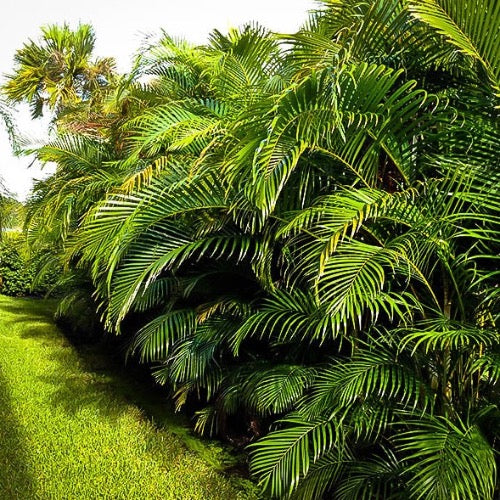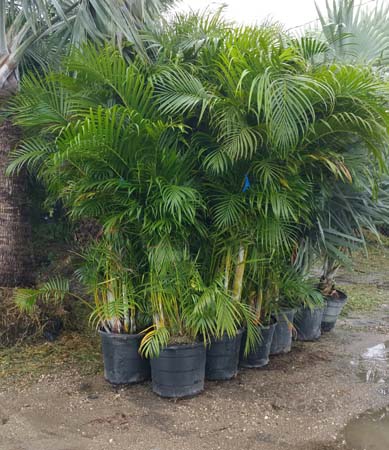If you’re thinking about adding a lush, tropical touch to your Florida landscape, the Areca Palm is an excellent choice. But did you know that planting it at the right time can make all the difference in how well it grows?
Choosing the best time to plant your Areca Palm in Florida means giving it the strongest start, helping it thrive in the Sunshine State’s unique climate. You’ll discover exactly when to plant your Areca Palm for the healthiest roots and the most vibrant growth.
Keep reading to learn the simple timing secrets that will turn your garden into a green paradise.
Planting Season In Florida
Choosing the right planting season for Areca Palm in Florida is key to healthy growth. Florida’s warm climate supports palm growth most of the year. Still, certain seasons offer clear benefits for planting. Understanding these seasons helps your Areca Palm thrive from the start.
Summer Advantages
Summer is warm and wet in Florida. This rain helps new palms get enough water. The soil stays warm, helping roots grow fast. Areca Palms planted in summer develop strong roots quickly. Frequent watering needs drop as natural rain nourishes the soil.
Spring Planting Benefits
Spring has mild temperatures and less rain than summer. It allows palms to adjust without stress. Roots start growing before the heat arrives. Spring planting gives Areca Palms time to settle. This helps them handle the hot summer months better.
Avoiding Winter Stress
Winter in Florida can bring cold snaps. These chills can harm young Areca Palms. Avoid planting in winter to prevent frost damage. Established palms handle cold better than new ones. Planting before winter gives palms time to grow strong roots.

Credit: plantittampabay.com
Climate Impact On Growth
The growth of Areca Palm in Florida depends greatly on the climate. Understanding how temperature, rainfall, humidity, and sunlight affect the palm helps in choosing the best planting time. The right climate conditions boost strong roots and healthy leaves. Poor weather can slow growth or harm the plant. Below are key climate factors affecting Areca Palm growth in Florida.
Temperature Effects
Areca Palms thrive in warm temperatures between 65°F and 85°F. Cooler weather below 50°F can cause stress or damage to the palm. Florida’s mild winters usually protect the palm from cold. Planting during late spring or early summer allows the palm to grow before cooler months. Hot soil and air encourage root development and leaf growth.
Rainfall And Humidity
Areca Palms prefer moderate to high humidity, common in Florida’s wet season. Rainfall helps keep the soil moist, which supports root establishment. The wet season from June to September is ideal for planting, as the palm gets enough water naturally. Dry spells require extra watering to prevent the palm from drying out. High humidity also reduces stress on the leaves and keeps them green.
Sunlight Requirements
Areca Palms need bright, indirect sunlight to grow well. Too much direct sun can burn the leaves, especially in the afternoon. Planting in a spot with filtered light or partial shade helps the palm thrive. Morning sun with afternoon shade is best in Florida’s strong sunlight. Proper light exposure ensures healthy foliage and steady growth.
Soil And Water Needs
The Areca palm thrives best with proper soil and water care. Healthy soil and regular watering help the palm grow strong roots. These two factors affect how well the plant adapts to Florida’s climate. Understanding the soil and water needs ensures your Areca palm stays lush and vibrant.
Soil Type Preferences
Areca palms prefer sandy, loamy soil rich in organic matter. This soil type holds moisture without becoming soggy. It also allows roots to breathe well. Avoid heavy clay soils because they retain too much water. Mixing compost into the soil improves fertility and texture for better growth.
Drainage Importance
Good drainage is critical for Areca palms. Water must flow away quickly to prevent root rot. Plant the palm where water does not collect after rain. Raised beds or mounds help improve drainage in flat areas. Proper drainage keeps roots healthy and avoids fungal diseases.
Watering Schedule
Water the Areca palm regularly, especially after planting. Keep the soil moist but not flooded. In Florida’s rainy season, natural rainfall often meets water needs. During dry periods, water deeply once or twice a week. Check soil moisture to avoid overwatering or drying out.

Credit: www.south-florida-plant-guide.com
Planting Techniques
Planting Areca palms correctly ensures they grow healthy in Florida’s climate. Proper techniques reduce transplant shock and help roots establish quickly. Follow simple steps to give your palm the best start.
Handling Root Ball
Keep the root ball intact when removing the palm from its container. Avoid shaking off soil around the roots. Damaging roots can slow growth and cause stress. Handle the palm gently to protect fine roots.
Proper Planting Depth
Plant the Areca palm at the same depth as it was in the pot. Planting too deep can cause root rot. Too shallow planting may expose roots to sun and dry out. Level the soil around the base to support the palm firmly.
Initial Watering Tips
Water the palm deeply right after planting to settle the soil. Keep soil moist but not soggy during the first few months. Frequent watering helps roots grow strong. Reduce watering gradually as the palm establishes itself.
Growth Rate Factors
Several factors influence how fast your Areca Palm grows in Florida. Understanding these helps you provide the best care. Each element plays a key role in the palm’s health and growth speed.
Proper attention to light, water, and soil can boost growth. These factors work together to support strong roots and vibrant leaves.
Light Exposure
Areca Palms thrive in bright, indirect light. Too much direct sun can scorch the leaves. Too little light slows growth and weakens the palm.
In Florida, morning sun with afternoon shade is ideal. This balance ensures your palm gets enough energy without stress.
Water Availability
Regular watering is vital for Areca Palms. The soil should stay moist but not soggy. Overwatering can cause root rot and stunt growth.
During Florida’s rainy season, natural water supports growth well. In dry spells, water your palm deeply once or twice a week.
Soil Quality
Well-draining soil with rich organic matter helps Areca Palms grow fast. Sandy loam soils common in Florida work well if amended properly.
Good soil allows roots to breathe and absorb nutrients easily. Adding compost or peat moss improves soil structure and fertility.
Mature Size And Form
The mature size and form of the Areca Palm play a key role in its use and care in Florida landscapes. Understanding its height, shape, and growth habit helps gardeners plan the right spot for planting. Areca Palms bring a tropical look with their graceful, feathery fronds and clumping stems. Their size is manageable, making them a popular choice for many yards and gardens.
Expected Height
Areca Palms typically grow between 6 and 12 feet tall in Florida. Some may reach up to 20 feet under ideal conditions. The height depends on soil quality, water, and sunlight. This moderate size fits well in small to medium garden spaces. It also suits patios and pool areas where tall palms are not practical.
Growth Habit
These palms grow in a clumping form with multiple stems. Each stem has thin, arching fronds that create a full, bushy appearance. The growth is steady but not too fast, allowing easy maintenance. Their soft texture and bright green color add a lush feel to any garden.
Privacy Screening Use
Areca Palms make excellent privacy screens because of their dense clumps. They block views and reduce noise without heavy pruning. Planting them close together forms a natural fence. This palm works well along property lines, patios, and around pools for added seclusion and beauty.
Areca Palm Care Tips
Areca palms thrive in Florida’s warm climate but need proper care to stay healthy. Understanding how to manage heat, pests, and pruning keeps your palm lush and vibrant. These care tips help your Areca palm grow strong and beautiful in Florida’s environment.
Dealing With Heat And Humidity
Areca palms prefer warm, humid conditions like those in Florida. Protect them from direct afternoon sun to avoid leaf burn. Water regularly, especially during dry spells, to keep soil moist but not soggy. Mulching helps retain moisture and cool roots. Good air circulation reduces the risk of fungal problems caused by humidity.
Pest And Disease Management
Watch for common pests like spider mites and scale insects. Inspect leaves and stems weekly for any signs of infestation. Use insecticidal soap or neem oil for safe pest control. Keep the area around the palm clean to prevent disease. Remove dead leaves promptly to stop fungal growth.
Pruning And Maintenance
Trim yellow or brown fronds to improve appearance and health. Use clean, sharp tools to avoid injury to the plant. Avoid cutting green fronds, as they provide food for the palm. Regular pruning encourages new growth and keeps the palm tidy. Check the base for any signs of rot or damage during maintenance.
Coastal Planting Considerations
Coastal areas in Florida have unique challenges for planting Areca palms. The salty air, strong winds, and sandy soils require special care. Understanding these factors helps your palm grow healthy and strong near the coast.
Choose the right location and prepare your palm for coastal conditions. This ensures it will thrive despite the environment’s stress.
Salt Spray Tolerance
Areca palms show good tolerance to salt spray. Their leaves can handle occasional salt without damage. Still, heavy salt exposure may cause leaf burn. Rinsing the leaves with fresh water helps reduce salt buildup. Planting palms a little inland from the shore can lower salt spray effects.
Wind Resistance
Strong coastal winds can harm young Areca palms. These palms have flexible stems that bend but do not break easily. Protect new palms by planting near windbreaks like fences or shrubs. Avoid open, exposed sites where wind speeds are high. Regular watering keeps palms healthy and better able to resist wind stress.
Site Selection
Choose a planting site with well-drained soil and some shade from the afternoon sun. Coastal soils are often sandy and drain quickly, which suits Areca palms well. Avoid low spots where water may collect and cause root rot. Position palms away from direct ocean spray but close enough to enjoy the coastal breeze.

Credit: www.aqualityplant.com
Frequently Asked Questions
When To Plant Palms In Florida?
Plant palms in Florida during spring or early summer. Warm temperatures and rainy weather help roots establish quickly. Water frequently after planting.
Is Areca Palm, Florida Friendly?
Yes, Areca palm thrives in Florida’s tropical climate. It tolerates heat, humidity, and occasional salt spray, making it Florida-friendly.
How Fast Do Areca Palms Grow In Florida?
Areca palms in Florida grow moderately fast, about 3 to 6 feet per year under ideal conditions. They reach full height in several years.
Can Areca Palm Take Full Sun?
Areca palms prefer bright, indirect light but can tolerate some full sun in cooler climates. Avoid prolonged direct sunlight to prevent leaf burn.
Conclusion
Planting Areca palms in Florida during late spring or early summer works best. Warm temperatures and rainy weather help roots grow strong. Keep the root ball intact and plant at the right depth. Water your palm often after planting to support growth.
Patience is key, as roots develop before leaves grow fast. Following these tips ensures a healthy, beautiful Areca palm in your Florida garden.

